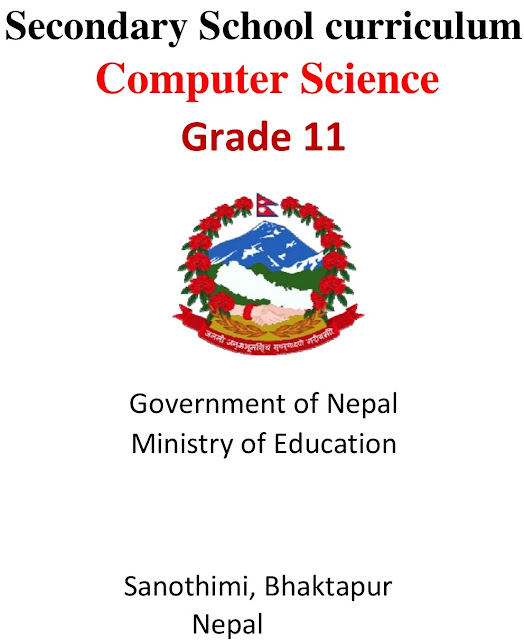Disclaimer: This is the old syllabus of NEB.For 2076 Upadted syllabus with PDF download option,visit: NEB 2076 Updated Syllabus
Grade XI NEB Syllabus -NEB Computer Science Syllabus
Computer Science
Teaching Hours: 150
I. Introduction of NEB Computer Science Syllabus
Information technology has become a part of contemporary society and a potential tool in the country’s socio-economic development. As information technology human resources is the backbone for the rapid development of the ICT sector in the country, the government of Nepal has accordingly identified IT as a priority sector. Keeping in view the importance of computer technology in general and the indispensability of its knowledge and skill to the society in general and the students of higher secondary level in particular, the course seeks to introduce computer science to acquaint the learner with the basic skills computer literacy.
II.General objectives of NEB Computer Science Syllabus
1. Help establish a strong foundation for the development of internationally competent human resources in the field of information communication and technology
2. Help decrease the digital device; and
3. Fulfill the middle-level ICT Human resources to the ICT industries.
III. Specific Objectives of NEB Computer Science Syllabus
After completing Computer Science Syllabus, the student will be able to:
1. Explain the fundamental principle of computer system mechanism and information and communication technology;
2. Identify computer recourse for any specific purpose PC based application in real-life situations;
3. Solve the office automation-related system problems, general skill about network, internet, email and web site design;
4. Provide computing knowledge and skill to individuals or organization;
5. Engage in the higher study of computer science and information technology course in the country or abroad;
6. Provide the services as an instructor of computer sciences course in schools or institutions;
7. State programming concept and tools;
8. Explain the state of art information technology and works to change agents for spreading ICT culture in their society; and
9. Encourage the student to visit the hardware and software industries, e-communities centres.
IV. Course contents of NEB Computer Science Syllabus
Unit 1. Introduction and Evolution of computer
Unit 2. Classification of Computer
1.1. Based on working principle- Analog, Digital and Hybrid Computers
1.2. Based on size- Super, Mainframe, Mini, and Microcomputers
1.3. Based on the brand- IBM PC, IBM Compatible, and Apple/Macintosh
1.4. Mobile Computing
Unit 3. Number system and their conversion
3.2. 3.2 9’s and 10’s complements decimal subtraction
3.3. Calculation in Binary-addition, subtraction, One’s and two’s Complement Methods binary subtraction
Unit 4. Logic Function and Boolean Algebra
Unit 5. Computer Systems
Unit 6. Operating System
6.1. Fundamental Concept
6.2. Disk Operating System (DOS)
6.3 windows operating system
6.4. Concept of Open Sources Operating System
Unit -7 Programming Concepts & Logics
Unit-8 Application Package
8.1 Word Processor
8.2 Spread Sheet
8.3. Presentation
Unit -9 Internet and E-mail
9.1. Internet
9.1.1. Introduction of Internet
9.1.2. Uses of the Internet
9.1.3. Concept of Protocols
9.1.4. Web Browser, Web page, Website, Web server, URL, DNS
9.1.5. Search Engine, Messenger services
9.1.6. Setting Browser properties
9.1.7. Setup Network Connection
9.2 E-mail
9.2.1. Concept of E-mail
9.2.2. Uses of E-mail
9.2.3. Different types of E-mail Account
9.2.4. Web Based on E-mail and POP E-mail
Unit- 10 Web page Designing
Unit-11. Final project work
11.1. Project work on a webpage or Spreadsheet
11.2. Documentation of the project
V. Instructional Materials:
•To be guided by Teaching Manual
VI. Instructional Techniques:
•To be guided by Teaching Manual
VII. Evaluation Schemes:
a) Theory Evaluation:
- Short Questions
- Long Questions
- Short Notes
b) Practical Evaluation:
|
S.No
|
Unit
|
Topics
|
No of
Exercise
|
Mini Projects Evaluation
|
Remarks
|
|
1
|
5
|
PC Component
Identification
|
2
|
–
|
Practical marks Evaluated By:
External
Examiner: 10
Internal
Examiner: 15
Based on the Mini Project, Lab Exercise and
Final Project
|
|
2
|
6.3
|
Operating
System
(windows)
|
4
|
–
|
|
|
3
|
8.1
|
Word Processor
|
6
|
5
|
|
|
4
|
8.2
|
Spreadsheet
|
5
|
5
|
|
|
5
|
8.3
|
Presentation
|
4
|
5
|
|
|
6
|
9
|
Internet, Email
|
4
|
2
|
|
|
7
|
10
|
Web Page
Designing
(HTML)
|
6
|
5
|
|
|
8
|
11
|
Final Project
|
|
|
VIII. Marks and Teaching Hours distribution
|
Units
|
Mark Distribution
|
Number of Hours
|
||
|
|
Theory
|
Practical
|
Theory
|
Practical
|
|
1
|
2
|
|
3
|
|
|
2
|
3
|
|
5
|
|
|
3
|
5
|
|
5
|
|
|
4
|
5
|
|
10
|
|
|
5
|
10
|
|
15
|
2
|
|
6
|
10
|
3
|
10
|
20
|
|
7
|
10
|
|
10
|
|
|
8
|
15
|
15
|
10
|
22
|
|
9
|
10
|
5
|
10
|
16
|
|
10
|
5
|
2
|
5
|
7
|
|
11
|
|
|
|
|
|
Total
|
75
|
25
|
83
|
67
|
IX. Reference books of NEB Computer Science
• Pudasaini, Dipak et.al, Computer Science Principles, and Practices XI, Buddha Prakashan, Ktm
• Adhikari Deepak et.al, Computer Science-XI, Asia Publication Pvt. Ltd, Ktm
• Sing, Bikash Kumar et.al. Computer Science-XI, Aatharai Publication Pvt. Ltd. Ktm
• Shrestha, Prachanda Ram et.al., Computer Science-XI, Asmita Books Publication, Ktm Gurung, Juddha Bahadur et.al, Computer Science-XI, Bhudipuran Prakashan, Ktm

[…] Also Read: NEB Computer Science Syllabus […]